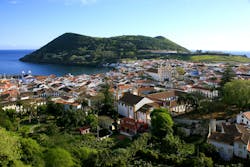Electricidade dos Açores (EDA), the Portuguese energy provider on the Azores island of Terceira, has taken receipt of a new sustainable energy project that features microgrid control software and an energy storage system.
The Azores is an archipelago off the Atlantic coast of Portugal that’s made up of nine volcanic islands. The region is popular with tourists thanks to its natural beauty and wildlife.
At just over 150 square miles, Terceira is one of the larger islands and is home to more than 50,000 people as well as a World Heritage site.
Each island in the archipelago has its own isolated autonomous energy system and is well-suited to take advantage of renewable energy resources including wind, solar, and geothermal.
EDA ultimately wants to have renewables account for up to 50% of its electricity mix, but for that to happen, fluctuations in renewable generation need to be addressed to ensure a reliable power supply for island residents and visitors.
Siemens microgrid software and battery energy storage
”This project is an important step towards a sustainable future for Terceira island and the Azores,” said Nuno Pimentel, CEO of EDA.
The new energy project includes Siemens' Spectrum Power Microgrid Management System (MGMS) software and a 15-MW battery based energy storage system from Fluence. Fluence is an energy storage company formed by Siemens and AES in 2018.
The MGMS software forecasts energy consumption and production and uses real-time monitoring and optimization of all power generation assets to ease the challenges associated with integrating intermittent renewable energy sources such as wind and solar into the island’s power grid.
The battery storage system is one of the largest stand-alone projects on a European island, according to Siemens. It’s designed to capture and store excess renewable energy that can then be fed back to the grid when needed to support demand.
“Battery-based energy storage is critical to increasing the share of renewables and decarbonizing island power systems,” said Paul McCusker, SVP & EMEA president at Fluence.
The modular battery system can be expanded in the future as needed.
Reduced carbon emissions
According to Sabine Erlinghagen, CEO of Siemens Grid Software, connecting software and hardware, as was done with the Azores project, will be critical in advancing the energy transition.
It will also help to reduce carbon emissions by reducing the amount of energy produced by fossil fuels.
The microgrid management software and energy storage system is expected to reduce carbon emissions by more than 3,600 tons.
“The project allows us to better address the instability caused by fluctuating renewable resources like wind energy and can replace the diesel spinning reserve needed to cope with the challenges of maintaining grid stability and the power quality requirements of an isolated system like ours at all times,” said Pimentel.
Erlinghagen noted that the project “demonstrates how to steadily expand renewables and integrate them into the power grid while reducing dependencies on fossil fuels and lowering CO2 emissions.”
Interested in microgrids? Join us in Anaheim, California May 16-17 for Microgrid 2023: Lights On!








